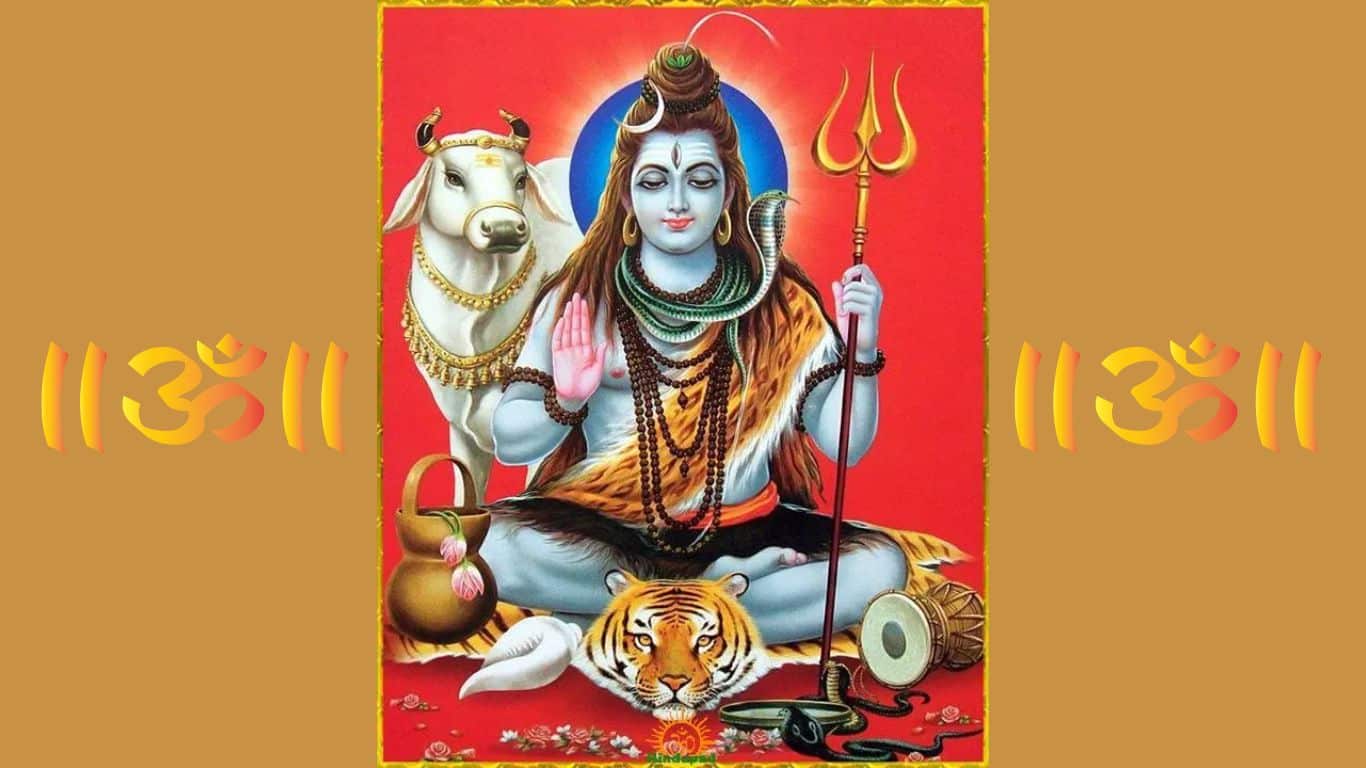Lord Shiva, also known as Mahadeva, is one of the most revered deities in Hinduism. He is the god of destruction and transformation, but also of creation and regeneration. Lord Shiva is often depicted in various forms, each symbolizing a different aspect of his nature and powers. Today, we will explore 9 different forms of Lord Shiva (from his countless forms).
9 Different Forms of Lord Shiva
Rudra

Rudra is considered to be one of the oldest and most primitive forms of Lord Shiva, and is often depicted as a fierce and wild deity. The name “Rudra” is derived from the Sanskrit word “Rud”, which means “to howl or roar”, and is associated with the destructive power of nature. In the Vedas, Rudra is considered to be the god of storms, hunting, and wild animals, and is often associated with the natural elements of wind, thunder, and lightning.
In Hindu mythology, Rudra is described as having various attributes and characteristics, including his fierce and terrifying appearance, his association with the hunt and the wild, and his destructive power. He is often depicted as having matted hair, a third eye on his forehead, and carrying weapons such as a bow and arrow, a trident, or a sword. He is also sometimes depicted riding a chariot drawn by wild animals.
Despite his fearsome appearance and reputation, Rudra is also associated with healing and protection. He is often worshipped as a protector from evil spirits and disease, and is also considered to have the power to grant boons and blessings to his devotees. In some traditions, Rudra is also associated with fertility and growth, as he is said to have the power to make plants and crops grow.
Rudra’s association with the storm and hunt is also reflected in his role as a destroyer of evil and negativity. In this aspect, he is considered to be the lord of the hunt, who destroys evil and protects the innocent. He is often depicted as having a fierce and wild nature, symbolizing the untamed power of nature and the need to respect and honor it. Rudra is an important and complex aspect of Lord Shiva, representing the primal and untamed aspects of nature, as well as the power of destruction and renewal. His worship is often associated with the power to protect and heal, as well as the need to respect and honor the natural world.
Pashupati

Pashupati is one of the forms of Lord Shiva in Hinduism. It is a Sanskrit word that translates to “Lord of Animals,” and in this form, Lord Shiva is worshipped as the protector and ruler of all living creatures. Pashupati is often depicted in Hindu mythology as a yogi sitting in a meditative pose with his consort, Parvati, by his side. He is adorned with various animal skins, and his body is covered with ash, which symbolizes his detachment from material desires.
The significance of Pashupati lies in the fact that Lord Shiva is believed to have a special relationship with the animal kingdom. He is often depicted with a snake around his neck, which represents his power over the deadliest creatures on earth. Additionally, Lord Shiva is believed to have a bull, Nandi, as his vehicle, which symbolizes his connection to the animal world.
The worship of Pashupati is prevalent in various parts of India, particularly in the regions of Nepal and Himachal Pradesh. In Nepal, the Pashupatinath Temple, located in the capital city of Kathmandu, is one of the most important and revered Hindu temples in the world. It is dedicated to Lord Pashupati and is considered one of the holiest sites for Hindu pilgrims.
In Hindu mythology, Lord Pashupati is associated with the qualities of compassion, strength, and protection. His worship is believed to bring blessings, prosperity, and success to those who seek his blessings. Pashupati is also associated with the cycle of birth and death, and his worship is believed to help individuals attain spiritual liberation and break free from the cycle of rebirth.
Mahadeva

Mahadeva is one of the most significant forms of Lord Shiva in Hinduism. The term Mahadeva means “Great God” or “Supreme God,” indicating that this form of Lord Shiva is considered the most powerful and revered among all the other forms. Mahadeva is also known as the Lord of Lords or the Great Lord, emphasizing his position as the highest authority in the Hindu pantheon.
Mahadeva is often depicted in Hindu mythology as a towering figure with four arms, holding a trident, a drum, a serpent, and a bowl of fire. He is usually adorned with snakes, which symbolize his power over death and rebirth, and wears a crescent moon on his forehead, representing his control over time and the changing phases of the moon.
As Mahadeva, Lord Shiva is considered the ultimate creator, preserver, and destroyer of the universe. He is believed to be the source of all existence and the force that governs the cycles of life and death. In this form, Lord Shiva is also associated with the divine principles of truth, compassion, and enlightenment. Mahadeva is often worshipped in temples dedicated to Lord Shiva across India and other parts of the world where Hinduism is practiced. Devotees offer prayers, flowers, and offerings to Lord Shiva in this form, seeking his blessings for protection, prosperity, and spiritual enlightenment. Many also believe that by worshipping Mahadeva, one can attain salvation and eternal peace.
Ardhanarishvara

Ardhanarishvara is a form of Lord Shiva in which he is depicted as half-man and half-woman, symbolizing the inseparable nature of masculine and feminine energies. The word “Ardhanarishvara” is derived from the Sanskrit words “ardha” meaning half, “nari” meaning woman, and “ishvara” meaning lord or god. This form of Lord Shiva represents the idea of unity and equality of the male and female aspects of creation.
In the Ardhanarishvara form, the right half of the body represents the masculine energy of Lord Shiva, while the left half represents the feminine energy of his consort, Goddess Parvati. The masculine half is usually depicted as having matted hair, a crescent moon on his forehead, and holding a trident and a snake. The feminine half is usually shown with a well-adorned feminine form, including jewelry and flowers, and holding a mirror and a lotus.
This form of Lord Shiva represents the idea that the entire universe is made up of two complementary energies – masculine and feminine. Just as day and night, light and dark, and sun and moon are inseparable and complementary, the masculine and feminine energies are also complementary and essential for the balance of the universe.
The Ardhanarishvara form of Lord Shiva also emphasizes the importance of balance and harmony in all aspects of life, including the balance between the rational and emotional aspects of the human psyche. This form of Lord Shiva teaches that in order to attain enlightenment and true understanding, one must recognize and embrace the unity of all things, including the union of masculine and feminine energies.
The Ardhanarishvara form of Lord Shiva is often depicted in art and sculpture, and is worshipped in various temples and shrines across India and other parts of the world where Hinduism is practiced. The symbolism of this form of Lord Shiva continues to be an important aspect of Hindu philosophy and spirituality, emphasizing the unity and balance of all aspects of creation.
Nataraja

Nataraja is one of the most famous and revered forms of Lord Shiva in Hinduism, and is depicted as the cosmic dancer who performs the Tandava, a powerful and dynamic dance that represents the cycle of creation, preservation, and destruction of the universe. In this form, Lord Shiva is often shown with four arms, two of which are raised in a dancing posture, while the other two hold a drum (damru) and a flame (agni).
The image of Nataraja is rich in symbolism, and each element of the depiction has a deep significance. For instance, Lord Shiva’s dancing posture is meant to represent the rhythm of the universe and the cycles of birth, death, and rebirth. His raised foot represents liberation and the triumph of good over evil, while his other foot rests on the demon Apasmara, who symbolizes ignorance and spiritual darkness.
The drum (damru) that Lord Shiva holds in his hand is said to represent the sound of creation, while the flame (agni) represents the energy of destruction. The circle of fire that surrounds Lord Shiva’s body is meant to symbolize the cosmic energy that sustains and drives the universe, while the snake coiled around his neck represents the kundalini energy that resides within every human being.
Bholenath

Bholenath is one of the most beloved forms of Lord Shiva, particularly among his devotees in North India. This form of Lord Shiva is characterized by his simplicity, humility, and childlike innocence. The word ‘Bholenath’ is derived from the Sanskrit words ‘bhole’ which means innocent, and ‘nath’ which means lord or master. Thus, Bholenath is often referred to as the “Innocent Lord” or the “Lord of Innocence.”
Bholenath is often depicted with a serene expression on his face, his eyes closed in deep meditation. He is typically shown wearing a rudraksha mala around his neck, and his hair is often disheveled and adorned with a crescent moon. In some depictions, he is also shown smoking chillum (a type of smoking pipe) or drinking bhang (a cannabis-based drink), which is believed to enhance his connection with the divine.
One of the most famous stories associated with Bholenath is the Samudra Manthan or the churning of the ocean of milk. According to Hindu mythology, the gods and demons came together to churn the ocean of milk to obtain the nectar of immortality. However, during the process, they also released a deadly poison called Halahala, which threatened to destroy the world. Lord Shiva then came forward and drank the poison, but instead of swallowing it, he held it in his throat, turning it blue. This act of selflessness and sacrifice earned him the name Neelkanth, meaning “the blue-throated one.” This incident is often depicted in art and is one of the most popular stories associated with Bholenath.
Bholenath is also associated with the concept of devotion or bhakti. It is believed that he is easily pleased by the devotion and love of his devotees, regardless of their social status or religious background. This is reflected in his simple and unpretentious way of life, and his willingness to accept offerings from his devotees, no matter how small or insignificant.
Kalabhairava

Kalabhairava is one of the many forms of Lord Shiva, representing his fierce and terrifying aspect. In Hindu mythology, Bhairava is known as the lord of terror, and he is often depicted with a frightening appearance, wielding weapons like a trident and a drum. His name is derived from the Sanskrit word ‘bhīru,’ which means fearful or terrifying.
Bhairava is also associated with the power of destruction and protection. He is believed to be the destroyer of all obstacles and the protector of the devotees who seek his help. It is said that worshipping Bhairava can help one overcome fear and obstacles in life.
In Hindu iconography, Bhairava is often depicted with a dog by his side, which symbolizes his loyalty and his role as a protector. He is also sometimes shown riding a dog or a chariot pulled by dogs. The dog is believed to represent loyalty and fearlessness, as well as the idea that Bhairava is beyond the boundaries of caste and class.
There are many temples dedicated to Bhairava in India, particularly in the state of Rajasthan. The most famous of these is the Kala Bhairava temple in Varanasi, which is believed to be one of the 64 Shakti Peethas, or sacred sites associated with the goddess Shakti.
Bhairava is worshipped in various forms and rituals, including the Bhairava Ashtami, a festival celebrated in his honor. During this festival, devotees offer prayers and offerings to Bhairava, seeking his protection and blessings.
Mahayogi

Mahayogi is also a form of Lord Shiva. In this form, Lord Shiva is depicted as a great yogi, symbolizing his mastery over meditation, spiritual practices, and inner transformation. The term ‘yogi’ refers to someone who practices yoga, which is a discipline that focuses on the physical, mental, and spiritual well-being of an individual.
Lord Shiva, in the form of Mahayogi, is often depicted sitting in a meditative posture, with his eyes closed, and his attention turned inward. His body is covered in ash, and he is adorned with serpents and other symbolic elements that represent his spiritual power and wisdom. This form of Lord Shiva is associated with the practice of yoga and meditation, which are believed to lead to self-realization and enlightenment.
The Mahayogi form of Lord Shiva is revered as the supreme guru, who guides his devotees on the path of spiritual growth and transformation. He is believed to possess profound knowledge and wisdom, and his teachings are considered to be a source of divine inspiration and guidance. Lord Shiva is also known as the Adi Yogi, or the first yogi, as he is believed to have taught the ancient knowledge of yoga to the sages and seers of ancient India.
The Mahayogi form of Lord Shiva is also associated with the practice of asceticism and renunciation, which are considered essential for spiritual growth and enlightenment. Lord Shiva is often depicted as a wandering ascetic, who has renounced all worldly pleasures and attachments in pursuit of spiritual knowledge and wisdom.
The Triambaka Form of Shiva

The Triambaka form of Lord Shiva is one of the lesser-known forms of the deity but is nonetheless significant in Hinduism. The word Triambaka is derived from two Sanskrit words, “tri” meaning three, and “ambaka” meaning eyes, and this form of Lord Shiva is depicted with three eyes.
In this form, Lord Shiva is depicted with a third eye on his forehead, which represents his spiritual wisdom and knowledge. According to Hindu mythology, Lord Shiva opened his third eye to destroy the demon god of lust, Kama, who was distracting him from his meditation.
The Triambaka form of Lord Shiva is also associated with the Ajna Chakra, or the third eye chakra, which is believed to be located in the center of the forehead. The third eye chakra is associated with intuition, spiritual insight, and psychic abilities, and its activation is said to lead to spiritual awakening and enlightenment.
In addition to the third eye, Lord Shiva in the Triambaka form is depicted with his two regular eyes, which represent his ability to see the past, present, and future. This symbolism represents Lord Shiva’s omniscience and his role as the lord of time.
The Triambaka form of Lord Shiva is often depicted in artwork and sculptures, with a crescent moon adorning his forehead, a snake around his neck, and his matted hair piled up in a jata or bun. He is usually depicted in a meditative posture, with his eyes closed or looking inward, symbolizing his mastery over the inner world.
Also Read: The Cosmic Dance of Lord Nataraj



